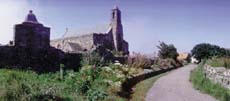The Symbolic Garden of Holy Island
 |
 |
 |
A roadside garden blooms with flowers symbolising 1300 years of Christianity on the holy isle of Lindisfarne |
The local community on the Holy Island of Lindisfarne in Northumberland have recreated a tiny garden along the Priory Wall. It is not only beautiful – the structure of flowers moves from colourful cottage garden flowers to wild herbs to the natural flora of the island – it is also meaningful.
With the help of Sacred Land and the British Library, local gardeners chose plants that reflected one of the most famous moments in the island's sacred history: the painting and writing of the Lindisfarne gospel.
 |
| St Aidan founded the first Lindisfarne monastery in 635AD. His successor was St Cuthbert who was a great healer, and when he died Lindisfarne became a pilgrimage place for people wanting to be healed |
|
 |
 |
Many of the flowers are featured in the gospel – entwined around the characters and pages. Other plants have an even more intimate connection with the precious book: they produced the dyes that were used to colour it.
But most of the flowers – which were probably more common in the 8th century than today – were chosen for their Christian symbolism. So the thorns and red berries of the hawthorn (which acts as a useful buffer for other plants against the wind) are a reminder of Christ’s Passion. Marigolds are named after ‘Mary's gold’, and rosemary is said in Christian legend to have borne white flowers until the very moment when Mary hid from Herod's soldiers behind the shrub, turning its flowers blue with her robes.
The garden designers have added locally rare species as part of a wider scheme for Northumberland. The range of plants is limited, because they have to withstand salt, sand, and 100 mph gales.
‘The garden is symbolic,’ says the designer Richard Binns, ‘And meant to make people happy in a simple kind of way.’
Visit the Lindisfarne website
|

